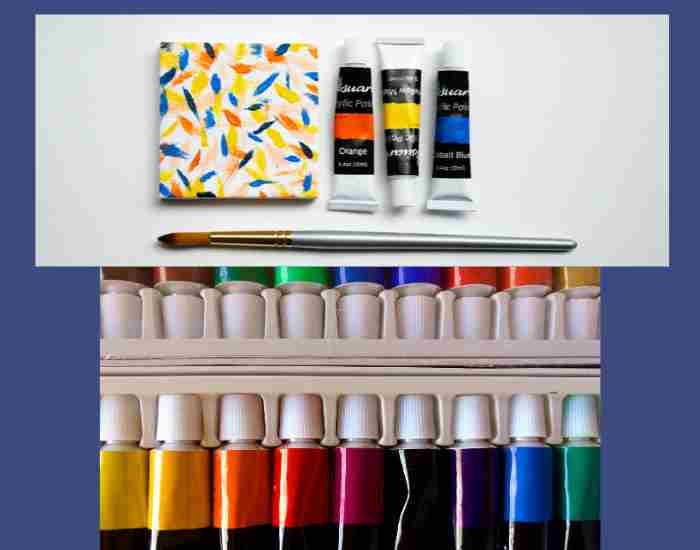Acrylic paint is a vibrant and versatile medium that has become a cornerstone in the world of art. Composed of pigments suspended in an acrylic polymer emulsion, it offers artists a wide range of possibilities in terms of color, texture, and application.
The popularity of acrylic paint has soared due to its quick-drying nature, which allows artists to build layers and experiment with different techniques. Its versatility spans various styles and genres, making it a favorite among both beginners and experienced artists.
The purpose of this post is to serve as a comprehensive guide to acrylic paint. We will delve into its rich history, explore its composition and ingredients, discuss various techniques, and provide valuable insights for artists of all levels.

The History of Acrylic Paint
Early Developments and the Evolution of Acrylics: Acrylic paint’s journey began with early experiments in the 20th century. Initially, it was developed as an industrial coating, but its potential as an artistic medium was soon realized.
Key historical milestones
| Section | Subsection | Details |
|---|---|---|
| Invention and Early Uses | Invention of Acrylic Paint | Acrylic paint was invented in the 1940s, with the first commercially available product introduced by Liquitex in the 1950s. |
| Early Uses | Initially used in the commercial sector and signage due to its durability and fast-drying properties. | |
| Rise in Popularity in the Art World | Gaining Traction in the 1960s and 1970s | Acrylics gained popularity in the art world, becoming popular during the 1960s and 1970s. |
| Artists’ Embrace of Versatility | Artists began using acrylics for abstract expressionism, pop art, and other contemporary movements. | |
| Influential Artists and Movements | Iconic Artists Embracing Acrylics | Artists like David Hockney and Andy Warhol were drawn to acrylics for their vibrant colors and quick-drying qualities. |
| Connection to Pop Art Movement | Acrylics became closely tied to the Pop Art movement, reflecting the dynamic and accessible nature of popular culture. | |
| Comparison with Other Mediums | Acrylics vs. Oil Paints | Acrylics offer faster drying times compared to oil paints, making them an appealing choice for artists. |
| Acrylics vs. Watercolors | Acrylics are more forgiving than watercolors, offering a greater degree of versatility. | |
| The Niche of Acrylic Paint | Acrylics carved their niche as a versatile and accessible medium for artists. |
The Ingredients of Acrylic Paint
Acrylic paint consists of several key components that contribute to its unique characteristics.
| Topic | Details |
|---|---|
| Pigments: Types and Sources | Overview of pigments, including types and sources used in acrylic paints. |
| Types of Pigments | Acrylic paints use a variety of pigments, each offering distinct colors and properties. Common types include organic and inorganic pigments, each derived from different sources. |
| Sources of Pigments | Pigments can be natural, derived from minerals and plants, or synthetic, created through chemical processes. Understanding pigment sources helps artists choose colors with specific qualities. |
| Binder: Acrylic Polymer Emulsion | The binder in acrylic paint is an acrylic polymer emulsion, a water-based substance that holds the pigments together and adheres them to the painting surface. |
| Advantages of Binder | The acrylic polymer emulsion provides durability, flexibility, and water solubility, enabling artists to achieve various effects and styles. |
| Solvents and Additives | Overview of solvents and additives used in acrylic paints. |
| Solvents | Acrylic paints use water as a solvent, which makes them less toxic, easier to clean, and contributes to the quick drying time of the paint. |
| Additives | Additives, such as retarders or extenders, can modify drying times, increase transparency, or alter the texture of the paint. |
Varieties of Acrylic Paint
Acrylic paint comes in different formulations, each catering to specific artistic preferences and applications.
| Acrylic Types | Key Features |
|---|---|
| Heavy Body Acrylics | Consistency: Thick, buttery consistency; perfect for impasto techniques and textured applications. Ideal Uses: Great for building layers and creating three-dimensional effects. |
| Fluid/Liquid Acrylics | Consistency: More watery, ideal for fine details, glazing, and pouring techniques. Versatility: Achieves smooth, flowing effects, versatile for different painting styles. |
| Interactive/Open Acrylics | Drying Time: Extended drying time for reworking and blending colors. Flexibility: Perfect for a forgiving and flexible painting process. |
| Others (Acrylic Gouache, Acrylic Ink) | Acrylic Gouache: Offers a matte finish and vibrant colors, combining traditional gouache with acrylics. Acrylic Ink: Ideal for detailed work, illustrating, and mixed media, providing intense color and versatility. |
Safety and environmental considerations
- Safety: Acrylic paints are generally safe to use, especially when compared to solvent-based paints. Artists should, however, be mindful of proper ventilation and use, especially in enclosed spaces.
- Environmental Considerations: Acrylics are water-based and have a lower environmental impact compared to oil paints. Proper disposal methods and choosing eco-friendly products contribute to minimizing the ecological footprint.
Properties of Acrylic Paint
One of the defining characteristics of acrylic paint is its rapid drying time. Unlike oil paints, which can take days or even weeks to dry, acrylics typically dry within minutes or hours. This quick drying time has a profound impact on artistic technique.
- Layering: Artists can layer colors swiftly without waiting for each layer to dry, allowing for efficient and dynamic creation.
- Blending: While blending is challenging due to the fast drying, artists can experiment with wet-on-wet techniques or use retarders to extend drying times for smoother transitions.
More Post
From Classic Oil Paints to Cutting-Edge Digital Techniques ( The Evolution of Portrait Art)
The Impact of Street Art on Urban Culture and Community Identity (Exploring Iconic Murals)
Color Brightness and Stability
Acrylic paint is renowned for its vibrant and intense colors, providing artists with a wide spectrum to choose from. The color brightness and stability of acrylics are influenced by various factors, including:
- Pigment Quality: High-quality pigments contribute to brighter and more stable colors.
- Binder Quality: The acrylic polymer emulsion binder enhances color stability over time, preventing yellowing or fading.
Flexibility and adhesion
- Flexibility: Acrylic paint remains flexible when dry, allowing artists to work on flexible surfaces like canvas without fear of cracking or peeling.
- Adhesion: Acrylics adhere well to a variety of surfaces, including canvas, paper, wood, and even fabric, providing artists with the flexibility to explore different mediums.
Opacity and Transparency Options
Acrylic paint offers a range of opacity and transparency options, allowing artists to control the visibility of underlying layers and create unique effects.
- Opaque Colors: Cover surfaces completely, useful for solid backgrounds or bold statements.
- Transparent Colors: Allow underlying layers to show through, enabling artists to create subtle and layered compositions.
Longevity and Durability
Acrylic paint is known for its longevity and durability, ensuring that artworks stand the test of time.
- Resistance to Aging: Properly cared for acrylic paintings resist aging, yellowing, and deterioration.
- Durability: The durable nature of acrylics makes them suitable for various applications, including outdoor murals and installations.
Acrylic painting techniques
Mastering some fundamental acrylic painting techniques can open up a world of creative possibilities.
Washing
-
- Technique: Similar to watercolor, washing involves diluting acrylic paint with water to create a transparent color wash.
- Uses: Ideal for creating backgrounds or adding a light tint to the canvas.
Dry Brushing
-
- Technique: using a dry brush with minimal paint to create a scratchy, textured effect.
- Application: Great for adding highlights, texture, or a sense of movement.
Stippling
-
- Technique: applying small dots of paint with the tip of the brush to build up texture or shading.
- Effect: Creates a sense of depth and detail, especially in landscape or portrait painting.
Glazing
-
- Technique: applying a thin, transparent layer of paint over a dry layer to alter the appearance and color.
- Purpose: Used to adjust colors, add depth, and create a luminous effect.
Advanced Techniques
For more experienced artists, these advanced techniques can add complexity and texture to their work.
Impasto
-
- Technique: applying paint thickly so that brush or palette knife marks are visible.
- Effect: Creates a three-dimensional texture, adding a dramatic and tactile quality.
Texturing
-
- Approach: incorporating materials like sand or gesso into paint or using tools to create texture.
- Result: It adds unique tactile qualities to the painting, enhancing the visual experience.
Layering
-
- Method: building up multiple layers of paint, allowing each to dry before applying the next.
- Advantage: Develops depth and richness in the painting with complex color interactions.
Mixed Media Applications
- Combining Materials: Acrylics can be mixed with other mediums, like collage materials, pen and ink, or pastels, for creative effects.
- Flexibility: The quick-drying and adaptable nature of acrylics makes them ideal for mixed media art.
Tips for Beginners and Common Mistakes to Avoid
- Start Simple: Begin with basic techniques and gradually experiment.
- Avoid Overworking: Acrylics dry fast; excessive manipulation can lead to muddy colors.
- Mind the Drying Time: Be aware of the quick-drying nature to prevent unwanted drying or blending.
Tools and Materials: Brushes, Palettes, Canvases, etc.
- Brushes: A range of brushes (round, flat, and filbert) is essential for different techniques.
- Palettes: Used for mixing colors, a wet palette can keep acrylics moist.
- Canvases: Stretched canvas or acrylic paper are popular choices; however, acrylics adhere to various surfaces.
Acrylics in the Modern Art Scene
Acrylic paint has established a significant presence in the contemporary art world, thanks to its versatility and ease of use. This section delves into current trends, notable artists, and the expanding role of acrylics in various art forms.
Current Trends in Acrylic Painting
In recent years, acrylic painting has seen several evolving trends that highlight the medium’s adaptability and range:
- Mixed Media: Artists are increasingly combining acrylics with other materials like collage, pen and ink, or digital elements to create multi-dimensional works.
- Textural Techniques: There’s a growing interest in using acrylics for impasto and other textural techniques, emphasizing tactile experiences.
- Sustainability: Eco-conscious artists are exploring sustainable practices in acrylic painting, including the use of environmentally friendly materials and methods.
Notable Contemporary Artists and Their Works
Several contemporary artists have made a significant impact on the acrylic painting scene:
- El Anatsui: Known for his large-scale tapestries made of recycled materials, he often incorporates acrylic paint to add color and texture.
- Yayoi Kusama: Famous for her psychedelic colors and patterns, Kusama frequently uses acrylics in her vivid paintings and installations.
- Banksy: The elusive street artist often uses acrylics in his socially and politically charged artworks, combining paint with stenciling techniques.
Acrylic Paint in Digital and Commercial Art
Acrylic paint’s influence extends beyond traditional canvases into the digital and commercial realms.
- Digital Art: Digital artists draw inspiration from acrylic painting techniques to create digital brushes and textures that mimic the look and feel of acrylics.
- Commercial Art: Acrylics are widely used in advertising, illustration, and fashion design due to their bright colors and versatility.
Community and educational resources
For those interested in exploring acrylic painting, there are abundant resources available:
- Online Platforms: Websites, blogs, and video tutorials offer a wealth of information and guidance for artists of all levels.
- Art Classes and Workshops: Many community centers, art schools, and galleries offer classes focused on acrylic painting techniques.
Social Media Groups: Online communities and social media platforms provide a space for artists to share their work, exchange tips, and offer support.
Caring for Acrylic Art
Preserving acrylic artworks ensures their longevity and vibrancy over time. Here are some best practices:
- Avoid Direct Sunlight: Prolonged exposure to direct sunlight can cause colors to fade. Display artworks in spaces where they are shielded from harsh sunlight.
- Proper Storage: When not on display, store acrylic paintings in a cool, dry place, away from extreme temperatures or humidity.
- Handle with Care: Always handle paintings with clean, dry hands. If moving or transporting, use protective packaging to prevent scratches or damage.
Cleaning and maintenance tips
Maintaining the cleanliness of acrylic paintings is essential for their visual appeal.
- Dust Regularly: Dust gently with a soft, clean brush or microfiber cloth to prevent particles from settling on the surface.
- Avoid water: Unlike oil paintings, acrylics are water-soluble. Use dry methods for cleaning, and avoid wet cleaning to prevent damage.
- Professional Cleaning: For stubborn dirt or grime, consult a professional conservator for expert cleaning and restoration.
Framing and Display Considerations
Choosing the right frame and display method enhances the overall presentation of acrylic paintings.
- Choose UV-Protective Glass: When framing, opt for UV-protective glass to minimize sun exposure and protect against fading.
- Matting and Spacers: Use acid-free matting to prevent contact between the painting and glass. Spacers help maintain a gap between the artwork and the glazing.
- Proper Hanging: Ensure paintings are securely hung using appropriate hooks and wires. Avoid hanging them in areas prone to temperature fluctuations or dampness.
More Post
Most Common Standard Photo Sizes and Aspect Ratios
11 Best Types of Paint Brushes and How Should You Use Them
10 Top Instagram Tips for Artists
DIY Projects and Creative Ideas with Acrylic Paint
Home Decor Projects
Acrylic paints offer endless possibilities for transforming your living spaces.
- Canvas Wall Art: Create personalized canvases to adorn your walls with vibrant colors and unique designs.
- Furniture Makeovers: Revitalize old furniture by painting it with acrylics, adding a pop of color to your home.
Crafting with Acrylics
Engage in fun and imaginative crafting projects with acrylics.
- Customized Accessories: Paint and personalize accessories like shoes, bags, or jewelry for a unique touch.
- Decorative Items: Craft personalized gifts or home decor items such as coasters, plant pots, or vases.
Innovative Uses in Fashion and Design
Explore unconventional applications of acrylic paint in the world of fashion and design:
- Fabric Painting: Create custom-designed clothing by applying acrylic paint directly to fabric, allowing for endless possibilities in wearable art.
- Upcycled Fashion: Transform old clothing items into trendy and unique pieces with acrylic paint.
Acrylic paints are not limited to traditional canvas paintings; they offer a versatile medium for a wide range of creative DIY projects, allowing individuals to infuse their personal style into their living spaces and everyday items.
The Future of Acrylic Paint
Technological Advancements in Acrylic Paint Formulations
The future of acrylic paint holds exciting possibilities with ongoing technological advancements.
- Nano-particle Pigments: Researchers are exploring nano-particle pigments that could enhance color intensity and provide new aesthetic possibilities.
- Smart Acrylics: Experimentation with responsive acrylics that change color or texture based on environmental factors or touch is an area of ongoing research.
Emerging Artists and Future Art Movements
The evolution of acrylic paint is closely tied to the emergence of new artists and art movements.
- Diverse Perspectives: As the art world becomes more inclusive, expect to see diverse artists using acrylics to express unique perspectives and narratives.
- Digital Integration: With the rise of digital art, the integration of acrylics into digital platforms and virtual reality spaces may become a significant trend.
Environmental considerations and sustainability
With an increasing focus on sustainability, the future of acrylic paint involves:
- Bio-based Binders: Research into bio-based binders to replace traditional acrylic polymer emulsions is reducing the environmental impact of production.
- Recyclable Packaging: Manufacturers may explore recyclable and eco-friendly packaging for acrylic paint products.
What is acrylic paint, and how is it different from other types of paint?
Acrylic paint is a water-based medium consisting of pigments suspended in an acrylic polymer emulsion. Unlike oil paints, acrylics dry quickly and are versatile in terms of texture and application. They offer a wide range of colors and are known for their durability. Unlike watercolors, acrylics are water-resistant when dry, allowing for layering and more forgiving techniques.
Can you provide a beginner’s guide to using acrylic paint?
Certainly! For beginners, start with basic techniques like washing, dry brushing, stippling, and glazing. Experiment with different varieties, such as heavy body and fluid acrylics, to understand their consistencies. Begin on a small scale and gradually explore more advanced techniques like impasto and layering. Invest in quality brushes, palettes, and canvases, and don’t forget to practice proper safety measures, considering the quick-drying nature of acrylics.
What are the key ingredients in acrylic paint, and how do they contribute to its properties?
The basic ingredients in acrylic paint include pigments, acrylic polymer emulsion (binder), solvents, and additives. Pigments provide color, the binder holds them together and adheres them to surfaces, and solvents and additives affect drying time and texture. The quality of the pigments and the binder influences color brightness, stability, and flexibility. Understanding these ingredients helps artists make informed choices and manipulate the properties of acrylic paint.
Can you highlight the historical significance of acrylic paint in the art world?
Acrylic paint has a fascinating history. Invented in the mid-20th century, it initially found use in the commercial sector before gaining popularity in the art world during the 1960s and 1970s. Influential artists like David Hockney and Andy Warhol embraced acrylics for their vibrant colors and quick-drying properties. Acrylics became synonymous with the Pop Art movement, reflecting the dynamic nature of popular culture. Today, acrylic paint continues to play a crucial role in contemporary art movements and remains a favorite medium for artists worldwide.
Conclusion
In conclusion, acrylic paint stands as a versatile and essential medium in the art world.
Adaptability: Acrylics can be used for a wide range of techniques, from traditional canvas paintings to innovative mixed-media projects.
Accessibility: With a quick-drying nature and ease of use, acrylics welcome artists of all levels to explore and experiment.
For aspiring artists, the versatility of acrylics offers an open canvas for exploration.
Experimentation: Embrace the flexibility of acrylics, try various techniques, and find your unique artistic voice.
Endless Possibilities: Whether you’re a beginner or an experienced artist, acrylics provide endless possibilities for creativity.
Your thoughts and experiences with acrylic painting are valuable.
Share Your Creations: Feel free to share your acrylic artworks, experiments, and discoveries.
Join the Conversation: Engage in discussions about techniques, challenges, and the future of acrylics in the artistic community.
As the journey with acrylic paint continues, let the exploration and collaboration within the artistic community inspire and shape the future of this dynamic medium.





